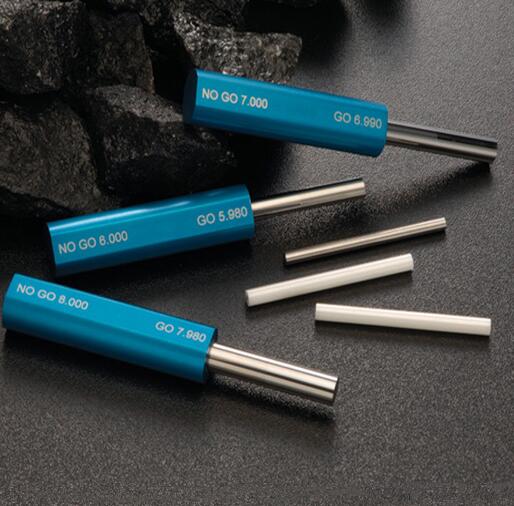Why Gauges Can Grow in Dimension?
Gauging is when a small amount of the material being measured is welded to the surface of the gauge, which causes the gauge to grow.
Hardened steel does have a tendency to increase in dimension.
This growth is usually noticed in larger dimensions because it is an inch per inch increase. What happens is that when the steel hardens, the molecules are trapped in a resting state. The molecules slowly relax and the residual austenite becomes martensite because their relaxation causes the material to expand. The gradual relaxation process takes about a year. The larger the size, the more pronounced the change. The tighter the tolerances, the more easily the movement is noticed.
To combat this, gage manufacturers require their hardened steels to be triple cold stabilized. This process requires the gage to be cycled through the freeze/thaw process 3 times. This process will reduce the likelihood of gage growth. Note the use of the word "reduce" rather than "eliminate". This is the primary reason for calibrating gauges every year, even if they are rarely or not used at all.
The likelihood of growth is most likely to be evident in the following cases.
1. If the Clear plastic is more than one inch. Growth is compounded, and it becomes more pronounced as the size gets larger. On smaller tools, growth is likely to be considered within the measurement uncertainty or interpreted as coming from different technicians, equipment or laboratory variations.
2. Within the first year after hardening. This is because most movements have aged in the first year. Factors such as temperature changes and meter use will promote faster aging. Not being used and left in the box may promote slower aging to some extent. Any growth detected after the first year will likely be considered within the measurement uncertainty or interpreted as coming from a different technician, equipment, or lab variation.

Gauling can cause gauges to become larger.
Gauging is when a small amount of the material being measured is welded to the surface of the gauge, which causes the gauge to grow. There are some materials, such as stainless steel and aluminum, that are easier to measure gauges on. Small amounts of material can be transferred from
Wear and tear
There are several conditions that may increase wear.
â–º The threads of the manufactured product are too close to the maximum material size. When this happens, the material touches the gauge more as the gauge is applied. To avoid this, try to keep the product size near the average.
â–º No oil on the gauge. Make sure the gauge is well lubricated. Lubrication means oiling. I know this part is covered by cutting oil. Although cutting oil is a cutting lubricant, it is not a gage lubricant. Gauges need real oil. The thickness of the oil will not affect the gage's ability to measure. The oil will only move away, but it will protect the surface of the gauge from wear.
â–º A fat thread will often cause the GO gage to make the thread fail. A slightly thicker thread will again approach the maximum material condition, resulting in wear to the gauge. A fat thread is caused by too fast a feed rate at the beginning of the thread making process. When cutting begins, the speed or feed moves the workpiece away from the cutting tool, or bends the cutting tool away from the workpiece. This needs to be prevented so that the gage is not affected.
â–º Fine pitch, larger diameter threads are a recipe for thread gauge wear. The more threads per inch, the more revolutions the gauge makes to obtain a full engagement, and therefore the longer the contact distance along the thread's helical path of friction.
Chips
The machining process may leave material chips in the threaded hole. If these chips are not removed, they may weld to the surface of the gauge or become stuck in the root of the gauge threads. The solution to this problem is simple: remove the chips. OK, removing them isn't always easy, but it must be done to extend the life of the gauge.
Burrs
These are materials that remain attached to the workpiece but protrude into the machined space left after cutting the threads. If not removed, they may weld themselves to the surface of the gauge. If burrs are a problem, using a different type of cutting tool, using a cutting tool for a second pass, a different speed or feed or just a wire brush can solve the problem.